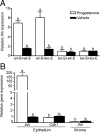Stromal progesterone receptors mediate induction of Indian Hedgehog (IHH) in uterine epithelium and its downstream targets in uterine stroma
- PMID: 19372202
- PMCID: PMC2717869
- DOI: 10.1210/en.2008-1691
Stromal progesterone receptors mediate induction of Indian Hedgehog (IHH) in uterine epithelium and its downstream targets in uterine stroma
Abstract
Uterine receptivity to embryo implantation depends on appropriate progesterone (P4) and estrogen stimulation. P4 rapidly stimulates production of the morphogen Indian hedgehog (IHH) in murine uterine epithelium as well as downstream molecules in the hedgehog pathway such as Patched homolog 1 (PTCH1) and nuclear receptor subfamily 2, group F, member 2 (NR2F2) in uterine stroma. Studies using IHH-null mice indicate that IHH is obligatory for the normal P4 response in the uterus. To determine whether IHH induction in uterine epithelium is mediated through P4 receptor (PR) in epithelium (E) and/or stroma (S), we produced tissue recombinants using uteri from neonatal PR knockout (ko) mice and wild-type (wt) mice containing PR in S and/or E or lacking PR altogether using a tissue recombinant methodology and assessed their response to P4. In tissue recombinants containing wt-S (wt-S + wt-E and wt-S + ko-E), P4 induced Ihh mRNA expression at 6 h that was 6-fold greater than in oil-treated controls (P < 0.05; n = 6) in both types of tissue recombinants despite the absence of epithelial PR in wt-S + ko-E grafts. Conversely, Ihh mRNA expression was unaffected by P4 in ko-S + ko-E and ko-S + wt-E grafts despite epithelial PR expression in the latter. Nr2f2 and Ptch1 mRNA expression was similar in that it was stimulated by P4 only in recombinants containing stromal PR. These results indicate that stromal PR is both necessary and sufficient for P4 stimulation of epithelial IHH as well as downstream events such as PTCH1 and NR2F2 increases in stroma.
Figures





Similar articles
-
Epithelial progesterone receptor exhibits pleiotropic roles in uterine development and function.FASEB J. 2012 Mar;26(3):1218-27. doi: 10.1096/fj.11-193334. Epub 2011 Dec 12. FASEB J. 2012. PMID: 22155565 Free PMC article.
-
Identification of Indian hedgehog as a progesterone-responsive gene in the murine uterus.Mol Endocrinol. 2002 Oct;16(10):2338-48. doi: 10.1210/me.2001-0154. Mol Endocrinol. 2002. PMID: 12351698
-
Indian hedgehog as a progesterone-responsive factor mediating epithelial-mesenchymal interactions in the mouse uterus.Dev Biol. 2002 May 15;245(2):280-90. doi: 10.1006/dbio.2002.0645. Dev Biol. 2002. PMID: 11977981
-
Molecular mechanisms involved in progesterone receptor regulation of uterine function.J Steroid Biochem Mol Biol. 2006 Dec;102(1-5):41-50. doi: 10.1016/j.jsbmb.2006.09.006. Epub 2006 Oct 25. J Steroid Biochem Mol Biol. 2006. PMID: 17067792 Free PMC article. Review.
-
In vivo analysis of progesterone receptor action in the uterus during embryo implantation.Semin Cell Dev Biol. 2008 Apr;19(2):178-86. doi: 10.1016/j.semcdb.2007.12.001. Epub 2008 Jan 6. Semin Cell Dev Biol. 2008. PMID: 18280760 Review.
Cited by
-
The Krüppel-like factors in female reproductive system pathologies.J Mol Endocrinol. 2015 Apr;54(2):R89-R101. doi: 10.1530/JME-14-0310. Epub 2015 Feb 5. J Mol Endocrinol. 2015. PMID: 25654975 Free PMC article. Review.
-
The progesterone receptor regulates implantation, decidualization, and glandular development via a complex paracrine signaling network.Mol Cell Endocrinol. 2012 Jun 24;357(1-2):108-18. doi: 10.1016/j.mce.2011.10.028. Epub 2011 Nov 17. Mol Cell Endocrinol. 2012. PMID: 22115959 Free PMC article. Review.
-
Epithelial progesterone receptor exhibits pleiotropic roles in uterine development and function.FASEB J. 2012 Mar;26(3):1218-27. doi: 10.1096/fj.11-193334. Epub 2011 Dec 12. FASEB J. 2012. PMID: 22155565 Free PMC article.
-
Expression and regulation of Foxa2 in the rat uterus during early pregnancy.J Reprod Dev. 2014;60(6):468-75. doi: 10.1262/jrd.2014-086. Epub 2014 Sep 29. J Reprod Dev. 2014. PMID: 25262775 Free PMC article.
-
A Role for Androgens in Epithelial Proliferation and Formation of Glands in the Mouse Uterus.Endocrinology. 2016 May;157(5):2116-28. doi: 10.1210/en.2015-2032. Epub 2016 Mar 10. Endocrinology. 2016. PMID: 26963473 Free PMC article.
References
-
- Matsumoto H, Zhao X, Das SK, Hogan BL, Dey SK 2002 Indian hedgehog as a progesterone-responsive factor mediating epithelial-mesenchymal interactions in the mouse uterus. Dev Biol 245:280–290 - PubMed
-
- Takamoto N, Zhao B, Tsai SY, DeMayo FJ 2002 Identification of Indian hedgehog as a progesterone-responsive gene in the murine uterus. Mol Endocrinol 16:2338–2348 - PubMed
-
- Lee K, Jeong J, Kwak I, Yu CT, Lanske B, Soegiarto DW, Toftgard R, Tsai MJ, Tsai S, Lydon JP, DeMayo FJ 2006 Indian hedgehog is a major mediator of progesterone signaling in the mouse uterus. Nat Genet 38:1204–1209 - PubMed
Publication types
MeSH terms
Substances
Grants and funding
LinkOut - more resources
Full Text Sources
Molecular Biology Databases
Research Materials

